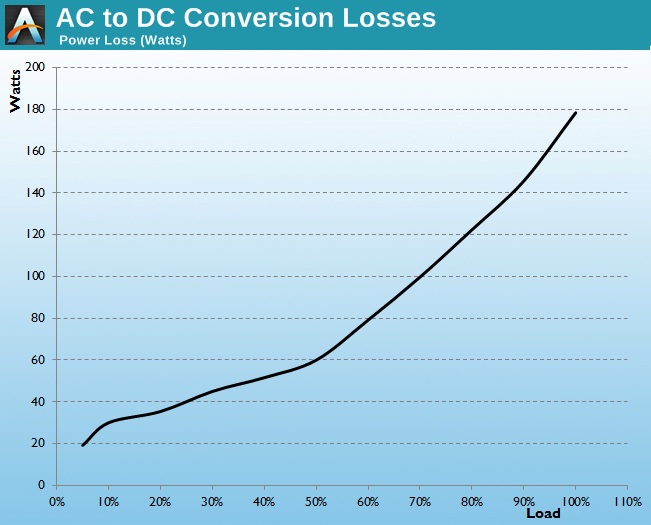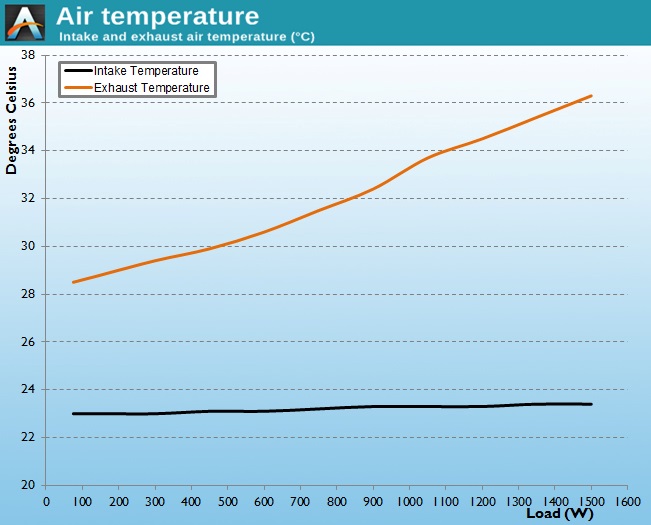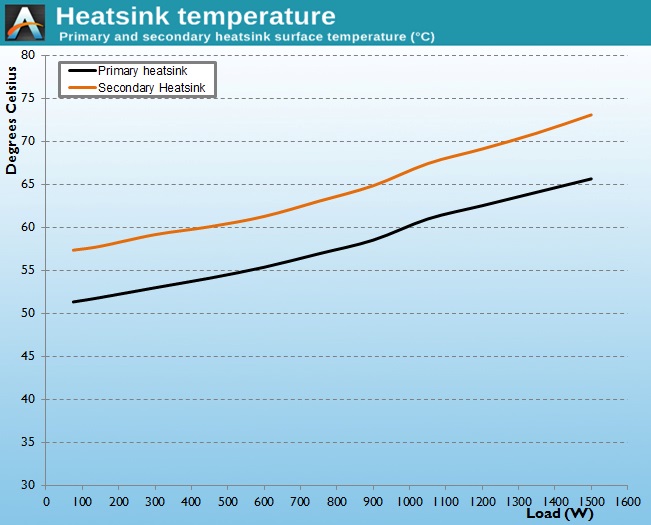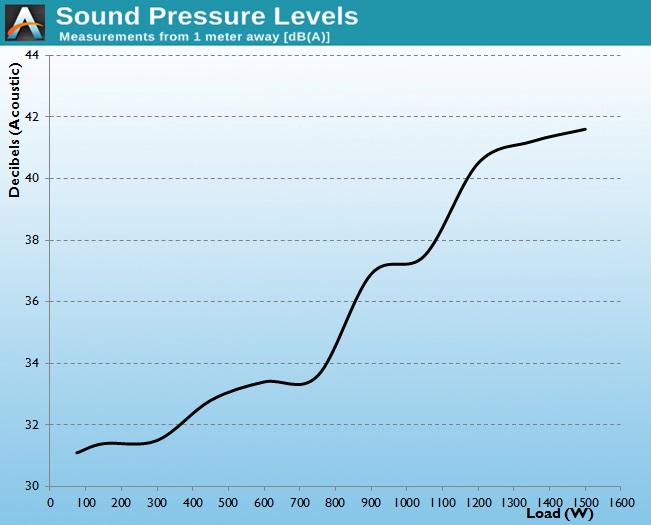The SilverStone Strider Gold S 1500W PSU Review
by E. Fylladitakis on April 7, 2015 8:00 AM EST- Posted in
- Cases/Cooling/PSUs
- PSUs
- SilverStone
- 1500W
Cold Test Results
For the testing of PSUs, we are using high precision electronic loads with a maximum power draw of 2700 Watts, a Rigol DS5042M 40 MHz oscilloscope, an Extech 380803 power analyzer, two high precision UNI-T UT-325 digital thermometers, an Extech HD600 SPL meter, a self-designed hotbox and various other bits and parts. For a thorough explanation of our testing methodology and more details on our equipment, please refer to our How We Test PSUs - 2014 Pipeline post.
The SilverStone Strider Gold S 1500W met its 80Plus Gold conversion efficiency requirements, even if only barely. We recorded a maximum conversion efficiency of 90% at 50% load and an average of 90.0% within the nominal load range (20% to 100% of the unit's capacity). Low load performance is mediocre, with the ST1500-GS maintaining an efficiency of 80% at 10% load, which drops to 74.4% at just 5% load. These are actually good figures considering the size of the power supply, yet they are nothing special by today's standards.
Always considering its massive power output, the ST1500-GS maintains very low internal temperatures. The primary heatsink of the PSU barely reached 67°C under maximum load, when the four transistors were pumping more than 1.5kW to the main transformer. This can be partially attributed to the "stepping" behavior of the cooling fan. While the load is low, the fan is barely audible when unobstructed, meaning that it would be virtually imperceptible with the PSU installed inside a case. At 55%-60% load, the speed of the fan steps up and the fan becomes audible, yet the noise output remains within comfortable limits. If the load exceeds 70% of the unit's capacity, then the fan speed steps up again, making the fan clearly audible and clearly prioritizing thermal performance over acoustics.















32 Comments
View All Comments
ShieTar - Thursday, April 9, 2015 - link
The Powercolor Devil13 (2x R9 290X) can pull loads in excess of 450W (and clear excess of the ATX specifications), so a crossfire setup with two of those and an AMD FX-9590 can exceed 1100W on CPU & GPU alone. Add Memory and a bunch of Harddrives, and maybe a dozen electronic gadgets on the USB ports, and you can use the 1500kW in extreme load cases.Not saying you should, an Intel 2011-3 system with two Titan X will give you more gaming power in barely over 600W peak power consumption.
Oxford Guy - Thursday, April 9, 2015 - link
One overclocked 290X hit 400 watts in Tom's testing. It was only a very brief spike, but those spikes should be factored in. So, three of those plus a 9590 and you're talking 1465 watts.jabber - Tuesday, April 7, 2015 - link
Handy review for the three or four that might need this.sweeper765 - Tuesday, April 7, 2015 - link
I would appreciate a different direction from the psu makers.With today's low power systems idling at 15-30W it would make more sense to focus on low load efficiency and smaller total power output, while maintaining the same quality components found in higher powered models.
darkfalz - Tuesday, April 7, 2015 - link
That describes most PSUs actually sold. The one in this review is strictly for e-peen who devote far too much of their income to their PCs.Samus - Tuesday, April 7, 2015 - link
People always overbuild their PSU's. They go for watts over quality. It's a consumer misunderstanding of power requirements and efficiency.Most OEM systems come with ~200-watt PSU's these days. Even high-end workstations like HP Z and Dell Precisions have 280-watt PSU's.
My Xeon workstation with a GTX970 has a 400-watt PSU and my Overclocked i7 SLI gaming PC has a 550-watt PSU, and both have headroom (peak draw from the wall for each under OCCT\furmark is 363-watts and 509-watts.)
I'm not saying a product like this has no reason to exist, but let's just say it's for "the 1%."
DanNeely - Wednesday, April 8, 2015 - link
The most recent 80+ spec, Titantium does focus on low load efficiency by requiring 90% efficiency at a 10% load. For all but the most severe cases of mis-matched system power and PSU size this will bring idle loads for systems with dGPUs into the high efficiency operating range.If OEMs actually refresh their low power models the same should be possible for IGP only boxes; but the negligible number of 80+ units of any size in that range make me suspect we'll be waiting a while for that to happen. Accommodating Haswell's deeper sleep states might push more of them to refresh their designs over the next year or two; but only 9/23 haswell compatable <400W models on newegg are gold certified (none are platinum). However the additional 432 non-haswell certified PSUs in that power bracket make it clear that this is going to be a very slow process. TBH for those systems actual amounts of power saved are small enough that it's only at very high power prices that a high efficiency PSU will pay for itself over a reasonable time horizon. Unless forced by regulators, I wouldn't hold my breath for any significant movement in the small PSU segment.
darkfalz - Tuesday, April 7, 2015 - link
Fools and their money hey... there are some people who purchase merely for the wattage number on the PSU. Says nothing of the quality and even less of the actual requirement. I wonder if this was a hangover from the days where a cheap 300W POS, er PSU would struggle to output 200W without exploding. I peaked 350 watts with a pretty hefty system (GTX 680, overclocked i5-3570K, 2 HDDs). That's 250 watts of headroom from my "low end" 600W PSU. Things might be different in AMD world but Intel/NVIDIA just keep getting more and more PPW.reininop - Tuesday, April 7, 2015 - link
I didn't read the full article, so I may be restating, but for all the people asking what you need 1500W for, the efficiency of these usually peaks at about 50 - 70% of rated power if I remember right. While even a 750 W pull is a pretty hefty system, there might be a slight market for the eco-conscious tech enthusiast...Okay, so maybe the audience is still only about 4 people.
DanNeely - Tuesday, April 7, 2015 - link
You obviously didn't read much if any of the article: You're way off.This is an 80+ gold unit which means that it needs to be >88% efficiency from 20-100% of full load (@220v, >87% at 110). It managed >90, and peaked at 92% efficient at a 50% load.
Sub 70% efficient power supplies are designs from a decade or more ago; and are long gone from the market (possibly excepting some of the sketchiest no-name models); bargain basement 80+ units are widely available now.
Lastly, the power rating is output power, not input. A hypothetical 50% efficient 1500W PSU would still output 1500W of power; it would however draw 3000W at the intake.